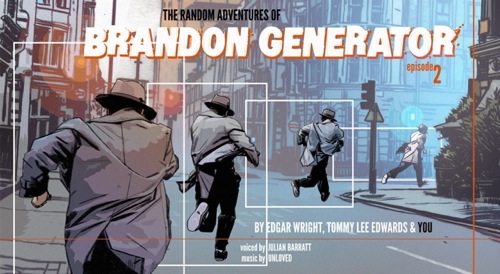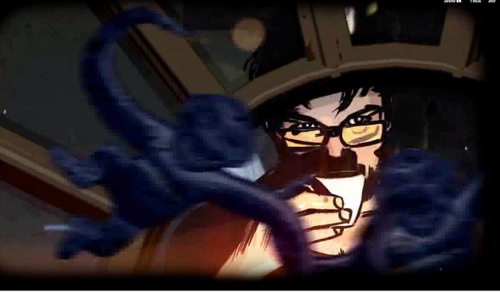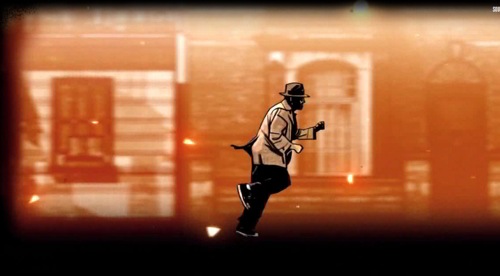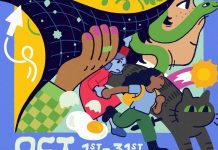by Serhend Sirkecioglu
My common complaint with the current wave of interactive/digital comics is the lack of ingenuity, risk, and execution, which fall into three camps. The first is the artist-centric camp where the person who made the comic is a competent cartoonist but has no knowledge of programming and is unconscious of interactivity, so the function feels gimmicky and not worth my time. The second is the program-centric, where the design is strong but the story is not much of a looker or read, and can feel more like a proof of concept than a whole-hearted piece. Finally, the third camp is the ones that peter out because the time and energy put into it outweighs the pay off, leading to burnout and an unfinished story.
Brandon Generator has none of these pitfalls and it’s a good step in the right direction for interactive storytelling.
This project was put together by Edgar Wright (writer and director), Tommy Lee Edwards (director, artist, and animation), Scott Benson (animation), CG work by Don Cameron, Daryl Bartley, Rodolfo DiMaggio, music by David Holmes, and narrated by Julian Barratt from The Mighty Boosh. This was all sponsored by Microsoft as a promo for Internet Explorer 9—good luck, they’re going to need it!
The story so far follows the titular Brandon, an author with writers block and his increasingly neurotic and surreal day. So far two of the four planned monthly episodes are up, with the run time at around 7 minutes each.
The interactive elements in the series is viewer generated content, comprised of images, doodles, text, and sound recording uploaded by the viewers. This content is then used to accent the main story through back drops and set pieces, such as the cleverly named “Caffiendo” a hat wearing spider-monster. This is a safe and yet liberating approach to getting the readers involved. The creative team still has control of the story and does not risk painting themselves into a corner or going in an unintended direction from giving the reader too much narrative power. The readers act as assistant art directors and bring a unrefined but genuine flavor to Edgar Wright’s genre savvy prose and Tommy Lee Edward’s loose and honest line which acts as a binder to the well timed CG and animated elements.
I enjoyed watching these episodes and I hope others going the interactive storytelling route take note when it comes to viewer generated content. There’s a lot of good to learn from here.
[Editor’s note: I love BRANDON GENERATOR! Very effective portrayal of writer’s block in the first episode, and as Serhand writes, the random elements of reader content works well in part 2. Plus: Caffeine addicts unite! A very well thought out piece even if it is for stinky Microsoft Exploder.]











Interactive and digital comics are two entirely different beasts. Digital comics aren’t supposed to be interactive at all. Interactive comics are, as any other interactive storytelling medium, closer to games.
Interactive and digital comics are two entirely different beasts. Digital comics aren’t supposed to be interactive at all. Interactive comics are, as any other interactive storytelling medium, closer to games.
It’s not really interactive in the point & click sense of something like Full Throttle- but an entertainment/commercial venture in crowdsourcing (a term I usually hate) for story ideas to use on future episodes. It’s slick and polished for sure- and well written enough (first episode- not into second yet)- but my question would be, can this kind of model be duplicated by anyone not backed by a major company? Unless Microsoft is going to be footing the bill for all the future incarnations I don’t see this style of entertainment expanding past this story- and that would be a shame since there’s plenty of potential.
@ Filippod, I personally think digital/interactive are terms on the same spectrum of meaning. digital comics restrict their interactivity to navigation while interactive comics go well beyond that.
@ John, production value wise it all depends on the individual/team and the art direction they take, but their balance of getting the viewers involved and keeping to their story is something to look up to. They still feel in control of the overall plot and yet have the wiggle room for some improvisation from content provided from the viewers.
All fiction is interactive. HOW interactive depends on the format and the audience.
There are many single-creator multi-path comics online:
Hapless Fame
MS Paint Adventures
Daniel Merlin Goodbrey’s hypercomics
There are also multi-path graphic novels, dating back to at least the early 1990s. (Prose novels go back to at least 1976: Sugarcane Island.)